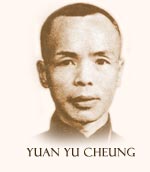|
Siu Lum (Shaolin)

The history of Chinese Buddhist martial arts is directly related to the earlier martial arts formulated and practiced by Buddhists in ancient India. In China there is a saying “all martial arts come from Siu Lum (Shaolin).” This implies that the martial arts which came from India through Siu Lum were extremely deep in design and powerful in application.
After the fall of the Ming dynasty in the seventeenth century the Siu Lum Temple became a sanctuary for rebels (Ming patriots) opposing the rule of the Manchus or Ching dynasty. In 1735 the governor of Honan province received an Imperial order to destroy the temple. Only five members of the temple survived. They are known today as the Five Elders of Ng Jo. Of those five, two members collaborated combining their individual arts together into one form. Those two were: |

Ng Mui Si Tai (Wu Mei): a Ch'an Buddhist nun of the temple and daughter of a commander in the Ming army, she specialized in the White Crane shape boxing, Bok Hoc Kuen (Bai He Quan) of kung-fu. Ng Mui had a very unique and specialized interpretation of the White Crane style. Its trademark was its use of the Hok Ma Bo (pigeon toed crane stance). She was the most senior in age of the five elders. After the destruction of the temple, Ng Mui fled to Bok Hok Gee (White Crane temple) located on Tai Leung Mountain near the Hunan / Szechuan border. [Another source states that Ng Mui fled to the Green temple located on Bok Hok Mountain.]
Ng Mui is said to have engineered or to have helped engineer several different styles of kung-fu including Fu Hok Yau Kong Fut Pai, Wing Chun, and Loong Ying Moor Kiu (Dragon Shape Rubbing Bridges). Ng Mui was famous for her skill in fighting atop the Mui Fa Jong or Plum Flower Posts. |

Jee Shin Shim Shee (Zhi Shan Ch’an Shi): a Ch'an Buddhist master, he specialized in the Tiger Shape Boxing (Fu Ying Kuen, Hu Xing Quan) and was expert with the staff. The Tiger style was well known for its precise stepping, low kicks and dynamic tension exercises. Jee Shin Shim Shee was also the abbot of the Siu Lum temple. After the destruction of the temple, Jee Shin Shim Shee sought refuge from the Ching by disguising himself as a cook on one of the Red Junk Opera boats. (One other source suggests that he may have fled to Gau Lin mountain in Fujian province). He co-engineered with Ng Mui the Fu Hok Yau Kong Fut Pai, and indirectly influenced the design of the Hung Gar style. |

Through repeated reflection and contemplation Ng Mui and Jee Shin integrated the Tiger style and Crane style into one style: Tiger Crane Soft Hard Buddhist Family Boxing (Fu Hok Yau Kong Fut Pai Kuen). The union of the two styles produced an even deeper style with an internal dimension not found in either of the previous two styles. The predominant feature of this new art was it’s practice of chi moor kwan. The Fu Hok Yau Kong Fut Pai system was the final “idea” to emerge from the Siu Lum Temple. |
|
The Yuan Family
 Between the years 1768 and 1815 the Fu Hok Yau Kong boxing expanded vigorously in northwest Canton (Guangdong). During this time the leadership of the Fu Hok Yau Kong boxing passed into the hands of the Yuan (Ruan) family. The oldest known member of the Yuan family operated an armed security service. Between the years 1768 and 1815 the Fu Hok Yau Kong boxing expanded vigorously in northwest Canton (Guangdong). During this time the leadership of the Fu Hok Yau Kong boxing passed into the hands of the Yuan (Ruan) family. The oldest known member of the Yuan family operated an armed security service.
Yuan Yu Cheung (Ruan Yu Xiang): During the struggle against the Communists, the disciples of the Fu Hok Yau Kong scattered and Yuan Yu Cheung took refuge in Hong Kong. It was here that Yuan Yu Cheung opened a physician’s office in the Kow Loon area near the intersection of Hamilton Street and Reclamation Street. It was at this time that the Fu Hok Yau Kong system was first openly taught to the public. Yuan Yu Cheung selected and taught ten disciples, fifth among them was Kwan Wing Hung. |
 |
The Modern Day

Kwan Wing Hung: Kwan Wing Hung eventually immigrated to the United States of America where he settled in the city of Atlanta. Together with his wife they operated a Chinese restaurant known as the “House Of Eng,” after its former owner Mr. George Eng. The restaurant was located between 10th and 14th streets on Peachtree. It was here in the back of his restaurant that Kwan Wing Hung introduced the Fu Hok Yau Kong to the western world.
|
 |
|